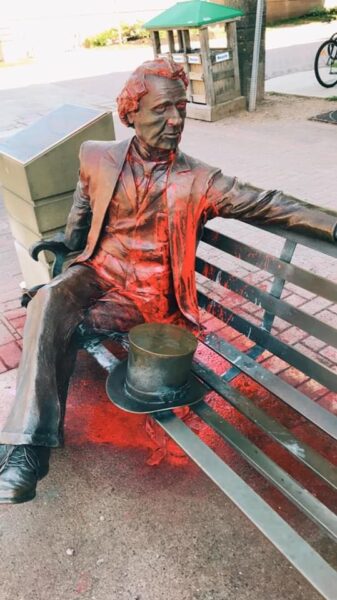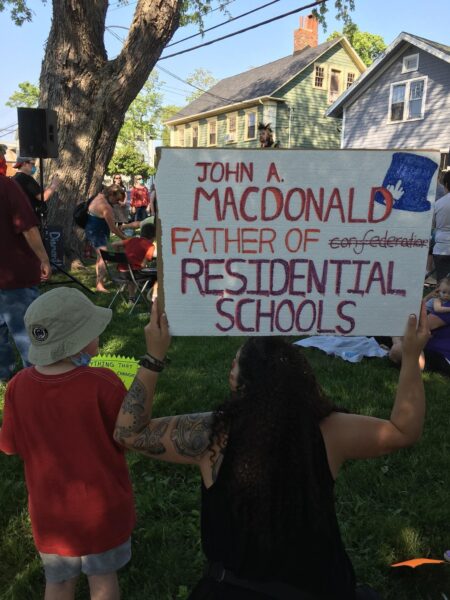
- Details
- By Native News Online Staff
CHARLOTTETOWN, Prince Edward Island — Organizers for a Healing Walk for Justice found out Friday that the statue of John A. MacDonald, Canada’s first Prime Minister, was doused with red paint Thursday night. The statue was on the path of the organized walk, which aimed to bring attention to the recent killing of two Indigenous people by law enforcement in the Canadian Province of Prince Edward Island.
“We just wanted to show our respect and walk in peace for our fallen brothers and sisters,” said Richard Pellissier-Lush, emcee of the Healing Walk for Justice.
But those who came out to show their support heard of the vandalism to the statue of John A. MacDonald prior to walking.
 Protestors want statue of John A. MacDonald taken down.
Protestors want statue of John A. MacDonald taken down.
“When I found out the statue was vandalized, I was happy,” said Healing for Justice Walk Organizer and Abegweit First Nation Member Wyonna Bernard. “We have wanted that statue gone as long as it’s been up.”
“He didn’t want one Indian left in Canada, but people celebrate him and it’s a slap in the face, to me,” Bernard said.
"There were rumors in the community saying it was us who did it,” Pellissier-Lush said. “But we had zero involvement.”
“I don’t condone vandalism, but I also don't stand for symbols of racism and hate,” said Organizer and Abegweit First Nation Member Sarah Lynn Bernard. “Our walk today was organized, peaceful, and from speaking with other organizers, we know the vandalism didn’t come from someone participating in our event.”
The Healing Walk for Justice came after a week where two Indigenous people, Chantel Moore and Rodney Levi, were killed by law enforcement in a span of eight days.
Moore, 26, was killed by an Edmundston Police Force officer during a wellness check in the early hours of June 4. Moore was a Tla-o-qui-aht/Nuu-chah-nulth woman from British Columbia. Judith Sayers, President of the Nuu-chah-nulth Tribal Council published a statement that said: “She was well loved by a very large family and many friends. And a nation mourns.
Levi, 48, was shot by a Royal Canadian Mounted Police (RCMP) Officer who was responding to a call for an unwanted person at a local church. The church, Boom Road Pentecostal Church, issued a statement about it Sunday that said Levi attended church, was loved by the congregation and will be missed.
“We recognize this is a deep loss to the Metepenagiag Mi’kmaq First Nation Community,” Boom Road Pentecostal Church said in the statement. “We are praying for his family, his friends, and the Mi’kmaq people.”
In an interview with the Canadian Broadcasting Corporation, Prince Edward Island Premier Dennis King said of the vandalism of the statue, “This is a difficult issue all across the country and all across the world, and I'm certainly interested in having a thorough discussion as to how we can best, as Prince Edward Island, represent the history of who we are, of how we've gotten to where we are, and not trying to sugar-coat and pick just parts of it.”
John A. MacDonald, Architect of Canada’s Indigenous Genocide
MacDonald was Canada’s first Prime Minister and is known for introducing the most damaging elements of Canadian Indigenous policy including residential schools that separated children from their families in effort to Christianize them.
One author, James Daschuk, said of MacDonald in his bestselling book Clearing the Plains, “Macdonald basically had Indigenous people locked down so tightly that they became irrelevant after 1885.”
Tribal Leaders Want Justice
First Nation leaders are calling for an Indigenous-led team to head the investigation into the deaths of Moore and Levi.
Ron Tremblay, Wolastoq Grand Council chief and elder, was heartbroken when he found out Saturday the BEI would be investigating Levi's death.
“We need our own Indigenous council to go investigate these murders because our people need to be a part of this,” Tremblay said to the National Post.
More Stories Like This
Native News Weekly (August 25, 2024): D.C. BriefsUS Presidents in Their Own Words Concerning American Indians
Next on Native Bidaské: Preserving Indian Health with A.C. Locklear
Hozhonigo Institute Helps Drive $34.5M in Grant Pipeline for Tribal Communities
Torres, LaMalfa Lead Push to Safeguard Culturally Important Tribal Seed Varieties
Help us defend tribal sovereignty.
At Native News Online, our mission is rooted in telling the stories that strengthen sovereignty and uplift Indigenous voices — not just at year’s end, but every single day.
Because of your generosity last year, we were able to keep our reporters on the ground in tribal communities, at national gatherings and in the halls of Congress — covering the issues that matter most to Indian Country: sovereignty, culture, education, health and economic opportunity.
That support sustained us through a tough year in 2025. Now, as we look to the year ahead, we need your help right now to ensure warrior journalism remains strong — reporting that defends tribal sovereignty, amplifies Native truth, and holds power accountable.
 The stakes couldn't be higher. Your support keeps Native voices heard, Native stories told and Native sovereignty defended.
The stakes couldn't be higher. Your support keeps Native voices heard, Native stories told and Native sovereignty defended.
Stand with Warrior Journalism today.
Levi Rickert (Potawatomi), Editor & Publisher

